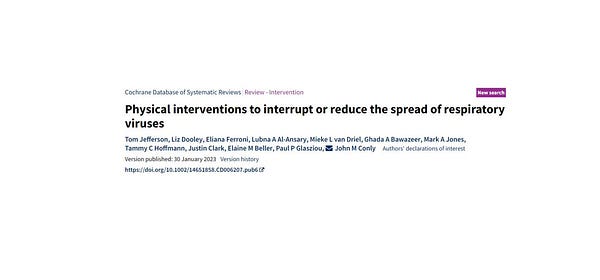
Bret Stephens, a conservative journalist with no public health, epidemiological, medical, atmospheric or aerosol science, indoor air quality, industrial hygiene, or engineering expertise, recently wrote an op-ed for The New York Times spreading misinformation about the effectiveness of mask wearing and mask mandates. I'm not sharing the link here. You can search for it if you'd like, but it's a poorly constructed argument. In my opinion, the Times was quite reckless in publishing it.
What I am sharing here (via The Conversation) is a nuanced interpretation/critique of the recent Cochrane Review that Stephens used to justify his anti-masking rant. The article, entitled Yes, masks reduce the risk of spreading COVID, despite a review saying they don’t, is by four actual experts - Dr. C. Raina MacIntyre, Dr. Abrar Ahmad Chughtai, Dr. David Fisman, and Dr. Trish Greenhalgh. I would also recommend reviewing this excellent twitter thread by Dr. Jennifer Nuzzo.


Numerous modeling, laboratory, real-world, and population level studies have demonstrated the effectiveness of mask wearing. The article and thread above provide links to some of these studies. One of the most recent was a waste water study finding that masks limited the spread of COVID in schools. For links to additional studies and further explanations see the following:
Twitter thread by Dr. Trish Greenhalgh

Twitter thread by Dr. Joseph Allen


Twitter thread by Dr. Julia Raifman


BranchPattern’s own modeling has also demonstrated the benefits of mask wearing.
The New York Times even shared an excellent overview of how masks work earlier in the pandemic.
As pointed out by the critiques of the Cochran Review, the effectiveness of masks and mask mandates are ultimately determined by an individual's ability to maintain proper fit, how consistently they wear them, and the effectiveness of the messaging associated with mandates or other collective mask wearing initiatives. Easy, equitable access to high efficiency masks are also critical.
Individual and collective behavior are key. Policy development, associated funding, and implementation are key. Politics and hyper-partisanship are key. Free market economic drivers, wealth disparities, institutional racism, and other factors that drive inequitable access to high efficiency masks and training are key.
These individual and collective behavioral factors are why masks and other PPE (personal protective equipment) are relegated to the bottom of the hierarchy of hazard controls inverted pyramid. But that doesn't mean we should throw up our hands and lament that it's impossible to get people, especially U.S. citizens, to collectively wear masks when needed. No, it means it's way past time to more effectively engage the relevant behavioral specialists as part of an interdisciplinary, or even transdisciplinary effort to address this, as I’ve covered elsewhere - The Disregard of Mask Wearing.


